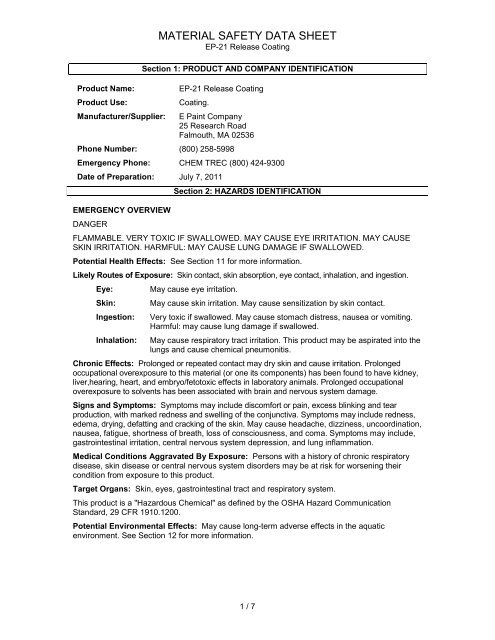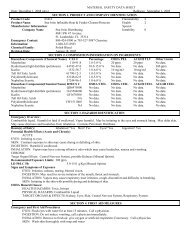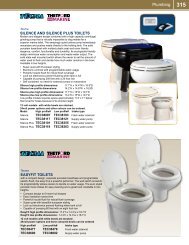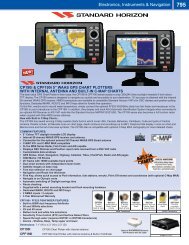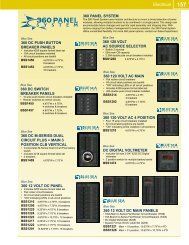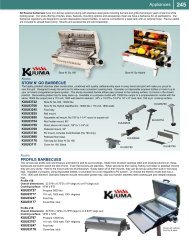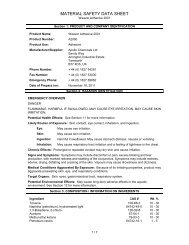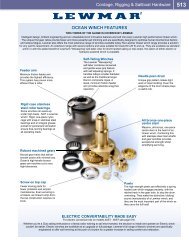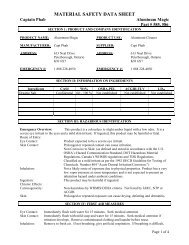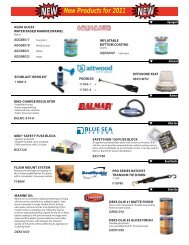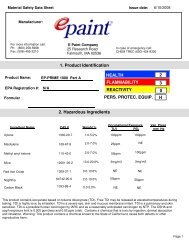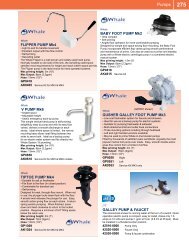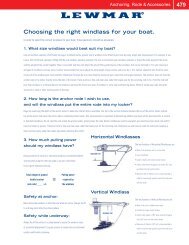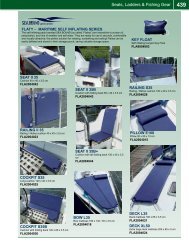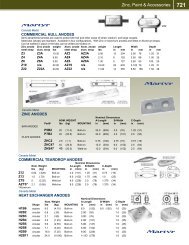EP21 - Paynes Marine Group
EP21 - Paynes Marine Group
EP21 - Paynes Marine Group
Create successful ePaper yourself
Turn your PDF publications into a flip-book with our unique Google optimized e-Paper software.
Product Name:<br />
Product Use:<br />
Manufacturer/Supplier:<br />
MATERIAL SAFETY DATA SHEET<br />
EP-21 Release Coating<br />
Section 1: PRODUCT AND COMPANY IDENTIFICATION<br />
EP-21 Release Coating<br />
Coating.<br />
E Paint Company<br />
25 Research Road<br />
Falmouth, MA 02536<br />
Phone Number: (800) 258-5998<br />
Emergency Phone: CHEM TREC (800) 424-9300<br />
Date of Preparation: July 7, 2011<br />
EMERGENCY OVERVIEW<br />
DANGER<br />
Section 2: HAZARDS IDENTIFICATION<br />
FLAMMABLE. VERY TOXIC IF SWALLOWED. MAY CAUSE EYE IRRITATION. MAY CAUSE<br />
SKIN IRRITATION. HARMFUL: MAY CAUSE LUNG DAMAGE IF SWALLOWED.<br />
Potential Health Effects: See Section 11 for more information.<br />
Likely Routes of Exposure: Skin contact, skin absorption, eye contact, inhalation, and ingestion.<br />
Eye:<br />
Skin:<br />
Ingestion:<br />
Inhalation:<br />
May cause eye irritation.<br />
May cause skin irritation. May cause sensitization by skin contact.<br />
Very toxic if swallowed. May cause stomach distress, nausea or vomiting.<br />
Harmful: may cause lung damage if swallowed.<br />
May cause respiratory tract irritation. This product may be aspirated into the<br />
lungs and cause chemical pneumonitis.<br />
Chronic Effects: Prolonged or repeated contact may dry skin and cause irritation. Prolonged<br />
occupational overexposure to this material (or one its components) has been found to have kidney,<br />
liver,hearing, heart, and embryo/fetotoxic effects in laboratory animals. Prolonged occupational<br />
overexposure to solvents has been associated with brain and nervous system damage.<br />
Signs and Symptoms: Symptoms may include discomfort or pain, excess blinking and tear<br />
production, with marked redness and swelling of the conjunctiva. Symptoms may include redness,<br />
edema, drying, defatting and cracking of the skin. May cause headache, dizziness, uncoordination,<br />
nausea, fatigue, shortness of breath, loss of consciousness, and coma. Symptoms may include,<br />
gastrointestinal irritation, central nervous system depression, and lung inflammation.<br />
Medical Conditions Aggravated By Exposure: Persons with a history of chronic respiratory<br />
disease, skin disease or central nervous system disorders may be at risk for worsening their<br />
condition from exposure to this product.<br />
Target Organs: Skin, eyes, gastrointestinal tract and respiratory system.<br />
This product is a "Hazardous Chemical" as defined by the OSHA Hazard Communication<br />
Standard, 29 CFR 1910.1200.<br />
Potential Environmental Effects: May cause long-term adverse effects in the aquatic<br />
environment. See Section 12 for more information.<br />
1 / 7
MATERIAL SAFETY DATA SHEET<br />
EP-21 Release Coating<br />
Section 3: COMPOSITION / INFORMATION ON INGREDIENTS<br />
Ingredient CAS # Wt. %<br />
Zinc oxide 1314-13-2 40 - 70<br />
Xylene 1330-20-7 5 - 10<br />
Rosin 8050-09-7 10 - 30<br />
Solvent naphtha (petroleum), heavy arom. 64742-94-5 7 - 13<br />
Ethylbenzene 100-41-4 < 0.1<br />
Polyamine amide salt HMIRC# 6722 0.5 - 1.5<br />
Eye Contact:<br />
Skin Contact:<br />
Inhalation:<br />
Ingestion:<br />
Section 4: FIRST AID MEASURES<br />
In case of contact, immediately flush eyes with plenty of water. Remove contact<br />
lenses, if worn. If irritation persists, get medical attention.<br />
In case of contact, immediately flush skin with plenty of water. Call a physician if<br />
irritation develops and persists.<br />
If breathed in, move person into fresh air. If not breathing, give artificial<br />
respiration. If breathing is difficult, give oxygen.<br />
If swallowed, do NOT induce vomiting unless directed to do so by medical<br />
personnel. Seek medical attention or call poison control.<br />
General Advice: In case of accident or if you feel unwell, seek medical advice immediately<br />
(show the label or MSDS where possible).<br />
Note to Physicians: Symptoms may not appear immediately.<br />
Section 5: FIRE FIGHTING MEASURES<br />
Flammability: Flammable by WHMIS/OSHA criteria.<br />
Means of Extinction:<br />
Suitable Extinguishing Media: Powder, foam, carbon dioxide.<br />
Unsuitable Extinguishing Media: Water.<br />
Products of Combustion: Oxides of carbon.<br />
Explosion Data:<br />
Sensitivity to Mechanical Impact: Not available.<br />
Sensitivity to Static Discharge: Not available.<br />
Protection of Firefighters: Keep upwind of fire. Wear full fire fighting turn-out gear (full Bunker<br />
gear) and respiratory protection (SCBA).<br />
Section 6: ACCIDENTAL RELEASE MEASURES<br />
Personal Precautions: Use personal protection recommended in Section 8. Isolate the hazard<br />
area and deny entry to unnecessary and unprotected personnel. Eliminate sources of ignition.<br />
Environmental Precautions: Many gases are heavier than air and will spread along ground<br />
and collect in low or confined areas (sewers, basements, tanks). Keep out of drains, sewers,<br />
ditches, and waterways. Minimize use of water to prevent environmental contamination.<br />
Methods for Containment: Contain and/or absorb spill with inert material (e.g. sand,<br />
vermiculite), then place in a suitable container. Do not flush to sewer or allow to enter<br />
waterways. Use appropriate Personal Protective Equipment (PPE).<br />
Methods for Clean-Up: Scoop up material and place in a disposal container. Provide ventilation.<br />
2 / 7
Other Information: Not available.<br />
MATERIAL SAFETY DATA SHEET<br />
EP-21 Release Coating<br />
Section 7: HANDLING AND STORAGE<br />
Handling:<br />
Keep away from sources of ignition. No smoking. Avoid contact with skin and eyes. Do not<br />
swallow. Do not breathe gas/fumes/vapor/spray. Use only in well-ventilated areas. Handle and<br />
open container with care. When using do not eat or drink. Wash hands before eating, drinking, or<br />
smoking.<br />
Storage:<br />
Keep out of the reach of children. Keep container tightly closed. Do not store at temperatures<br />
above 32 °C / 90 °F.<br />
Exposure Guidelines<br />
Section 8: EXPOSURE CONTROLS / PERSONAL PROTECTION<br />
Exposure Limits<br />
Ingredient OSHA-PEL ACGIH-TLV<br />
Zinc oxide<br />
5 mg/m 3 TWA (fume);<br />
15 mg/m 3 TWA (total dust);<br />
5 mg/m 3 TWA (resp) 2 mg/m 3 TWA (resp)<br />
Xylene 100 ppm 100 ppm<br />
Rosin Not available. Not available.<br />
Solvent naphtha (petroleum), heavy arom. Not available. Not available.<br />
Ethylbenzene 100 ppm 100 ppm<br />
Engineering Controls: Use ventilation adequate to keep exposures (airborne levels of dust,<br />
fume, vapor, etc.) below recommended exposure limits.<br />
Personal Protective Equipment:<br />
Eye/Face Protection: Wear eye/face protection.<br />
Hand Protection: Wear suitable gloves.<br />
Skin and Body Protection: Wear suitable protective clothing.<br />
Respiratory Protection: A NIOSH approved particulate respirator is recommended in<br />
poorly ventilated areas or when permissible exposure limits may be exceeded.<br />
Respirators should be selected by and used under the direction of a trained health and<br />
safety professional following requirements found in OSHA’s respirator standard (29 CFR<br />
1910.134) and ANSI’s standard for respiratory protection (Z88.2).<br />
General Hygiene Considerations: Handle according to established industrial hygiene and<br />
safety practices.<br />
Section 9: PHYSICAL AND CHEMICAL PROPERTIES<br />
Appearance:<br />
Color:<br />
Odour:<br />
Odour Threshold:<br />
Physical State:<br />
pH:<br />
Viscosity:<br />
Pigmented liquid.<br />
Not available.<br />
Aromatic.<br />
Not available.<br />
Liquid.<br />
Not available.<br />
Not available.<br />
3 / 7
Freezing Point:<br />
Boiling Point:<br />
Flash Point:<br />
MATERIAL SAFETY DATA SHEET<br />
EP-21 Release Coating<br />
Not available.<br />
~ 137.22 °C (~ 278.996 °F) @ 760 mm Hg<br />
~ 28 °C (~ 82.4 °F)<br />
Evaporation Rate: N-Butyl Acetate = 11.64<br />
Lower Flammability Limit:<br />
Upper Flammability Limit:<br />
Vapor Pressure:<br />
Vapor Density: 3.5<br />
Specific Gravity: 1.76<br />
Solubility in Water:<br />
Coefficient of Water/Oil Distribution:<br />
Auto-ignition Temperature:<br />
Percent Volatile, wt. %:<br />
VOC content, wt. %:<br />
Not available.<br />
Not available.<br />
Not available.<br />
Not available.<br />
Not available.<br />
Not available.<br />
Not available.<br />
Not available.<br />
Section 10: STABILITY AND REACTIVITY<br />
Stability: Stable under normal storage conditions. Keep in a cool place.<br />
Conditions of Reactivity: Heat. Incompatible materials.<br />
Incompatible Materials: Acids. Bases. Oxidizers.<br />
Hazardous Decomposition Products: Oxides of carbon.<br />
Possibility of Hazardous Reactions: No dangerous reaction known under conditions of normal use.<br />
EFFECTS OF ACUTE EXPOSURE<br />
Component Analysis<br />
Section 11: TOXICOLOGY INFORMATION<br />
Ingredient LD 50 (oral) LC 50<br />
Zinc oxide > 5000 mg/kg, rat 2500 mg/m 3 , mouse<br />
Xylene 4300 mg/kg, rat 5000 ppm 4hr, rat<br />
Rosin 3 mg/kg, rat Not available.<br />
Solvent naphtha (petroleum), heavy arom. > 5000 mg/kg, rat > 590 mg/m 3 4hr, rat<br />
Ethylbenzene 3500 mg/kg, rat 17.2 mg/L 4hr, rat<br />
Eye:<br />
Skin:<br />
Ingestion:<br />
Inhalation:<br />
May cause eye irritation. Symptoms may include discomfort or pain, excess blinking<br />
and tear production, with marked redness and swelling of the conjunctiva.<br />
May cause skin irritation. May cause sensitization by skin contact. Symptoms<br />
may include redness, edema, drying, defatting and cracking of the skin.<br />
Very toxic if swallowed. Symptoms may include, gastrointestinal irritation, central<br />
nervous system depression, and lung inflammation. Harmful: may cause lung<br />
damage if swallowed.<br />
May cause respiratory tract irritation. This product may be aspirated into the<br />
lungs and cause chemical pneumonitis. May cause headache, dizziness,<br />
uncoordination, nausea, fatigue, shortness of breath, loss of consciousness, and<br />
coma.<br />
4 / 7
EFFECTS OF CHRONIC EXPOSURE<br />
Target Organs: Not available.<br />
MATERIAL SAFETY DATA SHEET<br />
EP-21 Release Coating<br />
Chronic Effects: Not hazardous by WHMIS/OSHA criteria.<br />
Carcinogenicity: Not hazardous by WHMIS/OSHA criteria.<br />
Ingredient<br />
Zinc oxide<br />
Xylene<br />
Rosin<br />
Solvent naphtha (petroleum), heavy arom.<br />
Ethylbenzene<br />
* See Section 15 for more information.<br />
Mutagenicity: Not hazardous by WHMIS/OSHA criteria.<br />
Reproductive Effects: Not hazardous by WHMIS/OSHA criteria.<br />
Developmental Effects:<br />
Teratogenicity: Hazardous by WHMIS/OSHA criteria.<br />
Embryotoxicity: Hazardous by WHMIS/OSHA criteria.<br />
Respiratory Sensitization: Hazardous by WHMIS/OSHA criteria.<br />
Skin Sensitization: Hazardous by WHMIS/OSHA criteria.<br />
Toxicologically Synergistic Materials: Not available.<br />
Section 12: ECOLOGICAL INFORMATION<br />
Chemical Listed as Carcinogen or<br />
Potential Carcinogen *<br />
Not listed.<br />
Not listed.<br />
Not listed.<br />
Not listed.<br />
G-A3, I-2B, CP65<br />
Ecotoxicity: May cause long-term adverse effects in the aquatic environment.<br />
Persistence / Degradability: Not available.<br />
Bioaccumulation / Accumulation: Not available.<br />
Mobility in Environment: Not available.<br />
Section 13: DISPOSAL CONSIDERATIONS<br />
Disposal Instructions:<br />
This material must be disposed of in accordance with all local, state, provincial, and federal<br />
regulations.<br />
DOT Classification<br />
UN1263, Flammable Liquid, Class 3, PG III<br />
ORM-D (≤ 5L)<br />
TDG Classification<br />
UN1263, Flammable Liquid, Class 3, PG III<br />
Limited Quantity (≤ 5L)<br />
Section 14: TRANSPORTATION INFORMATION<br />
5 / 7
Federal Regulations<br />
MATERIAL SAFETY DATA SHEET<br />
EP-21 Release Coating<br />
Section 15: REGULATORY INFORMATION<br />
Canadian: This product has been classified in accordance with the hazard criteria of the<br />
Controlled Products Regulations and the MSDS contains all the information required by the<br />
Controlled Products Regulations.<br />
US: MSDS prepared pursuant to the Hazard Communication Standard (CFR29 1910.1200).<br />
SARA Title III<br />
Ingredient<br />
Section<br />
302 (EHS)<br />
TPQ (lbs.)<br />
Section<br />
304 EHS<br />
RQ (lbs.)<br />
CERCLA<br />
RQ (lbs.)<br />
Section<br />
313<br />
Zinc oxide Not listed. Not listed. Not listed. Not listed.<br />
Xylene Not listed. Not listed. 100 313<br />
Rosin Not listed. Not listed. Not listed. Not listed.<br />
Solvent naphtha (petroleum), heavy arom. Not listed. Not listed. Not listed. Not listed.<br />
Ethylbenzene Not listed. Not listed. 1,000 313<br />
State Regulations<br />
California Proposition 65:<br />
This product contains a chemical or chemicals known to the State of California to cause cancer.<br />
Global Inventories<br />
Ingredient<br />
Canada<br />
DSL/NDSL<br />
USA<br />
TSCA<br />
Zinc oxide DSL Yes.<br />
Xylene DSL Yes.<br />
Rosin DSL Yes.<br />
Solvent naphtha (petroleum), heavy arom. DSL Yes.<br />
Ethylbenzene DSL Yes.<br />
HMIS - Hazardous Materials Identification System<br />
Health - 3* Flammability - 3 Physical Hazard - 0 PPE – H<br />
NFPA - National Fire Protection Association:<br />
Health - 3 Fire - 3 Reactivity - 0<br />
Hazard Rating: 0 = minimal, 1 = slight, 2 = moderate, 3 = severe, 4 = extreme<br />
WHMIS Classification(s):<br />
Class B2 - Flammable Liquid<br />
Class D1A - Very Toxic Material<br />
Class D2A - Teratogenicity and Embryotoxicity<br />
Class D2A - Respiratory Sensitization<br />
Class D2B - Skin Sensitization<br />
Class D2B - Skin/Eye Irritant<br />
WHMIS Hazard Symbols:<br />
6 / 7
MATERIAL SAFETY DATA SHEET<br />
EP-21 Release Coating<br />
SOURCE AGENCY CARCINOGEN CLASSIFICATIONS:<br />
OSHA (O)<br />
ACGIH (G)<br />
IARC (I)<br />
NTP (N)<br />
Occupational Safety and Health Administration.<br />
American Conference of Governmental Industrial Hygienists.<br />
A1 - Confirmed human carcinogen.<br />
A2 - Suspected human carcinogen.<br />
A3 - Animal carcinogen.<br />
A4 - Not classifiable as a human carcinogen.<br />
A5 - Not suspected as a human carcinogen.<br />
International Agency for Research on Cancer.<br />
1 - The agent (mixture) is carcinogenic to humans.<br />
2A - The agent (mixture) is probably carcinogenic to humans; there is limited evidence of carcinogenicity in<br />
humans and sufficient evidence of carcinogenicity in experimental animals.<br />
2B - The agent (mixture) is possibly carcinogenic to humans; there is limited evidence of carcinogenicity in<br />
humans in the absence of sufficient evidence of carcinogenicity in experimental animals.<br />
3 - The agent (mixture, exposure circumstance) is not classifiable as to its carcinogenicity to humans.<br />
4 - The agent (mixture, exposure circumstance) is probably not carcinogenic to humans.<br />
National Toxicology Program.<br />
1 - Known to be carcinogens.<br />
2 - Reasonably anticipated to be carcinogens.<br />
Section 16: OTHER INFORMATION<br />
Disclaimer:<br />
The information contained in this document applies to this specific material as supplied. It may<br />
not be valid for this material if it is used in combination with any other materials. It is the user’s<br />
responsibility to satisfy oneself as to the suitability and completeness of this information for the<br />
user’s own particular use.<br />
Expiry Date: July 7, 2014<br />
Version #: 1.0<br />
Prepared by:<br />
Nexreg Compliance Inc.<br />
Phone: (519) 488-5126<br />
www.nexreg.com<br />
7 / 7


